Aztec
 For ancient aztecs, the knowledge of the night skies and stars movement had great importance for their calendars and the measurement of both agricultural and sacred cycles. However, great part of this knowledge was lost as consequence of the Spanish conquest which occurred on continental America in the 16th century.
For ancient aztecs, the knowledge of the night skies and stars movement had great importance for their calendars and the measurement of both agricultural and sacred cycles. However, great part of this knowledge was lost as consequence of the Spanish conquest which occurred on continental America in the 16th century.
The elements of the Aztec society such as culture, economy and science is preserved in the tlacuilos, word that comes from the ancient nahuatl word tlacuiloa, which means writing with drawings. These Tlacuilos where stored in the amoxcalli, meaning amoxtli: books and calli: house. Later their became known as codices; a word that came from the Latin word Codex which means written book.
After the spanish conquest many of the pre-hispanic Codexes where destroyed, their main feature is that their where drawn in many different materials such as deer skin, amate paper or cotton fabric and they had no text only draws or glifos. However the collection of Mesoamerican customs continued prior to the spanish conquest thanks to the work of some native indians and some spanish priests, this codexes are known as Colonial Codexes and there is a change of the way of drawing because of the new techniques of drawing and the new materials imported from Europe, also because of the incorporation of descriptive text both in spanish and nahuatl.
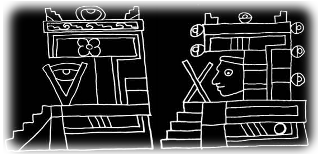
Astronomical building
Sadly, the Aztec astronomical knowledge in the remaining codexes is really small. The next image is one of the few that names some constellations and astronomical phenomena identified by the Aztec, it belong to the Primeros Memoriales (first memorials), wich is a colonial manuscript of the 16th century written by Fray Bernardino de Sahagun.
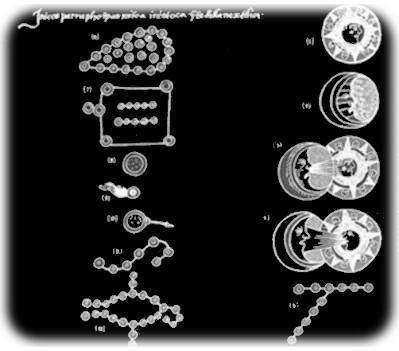
Now, in this work we have an explanation of some Aztec stellar figures for Stellarium.
Mamalhuaztli
 Ancient Aztec indentified the Orion's Belt as Mamalhuaztli, and it represented the wood sticks used to light the new fire in the commemoration celebrated every 52 years by the Mexicans and their neighbors named toxiuh molpilia wich means binding of the years and coincided with the beginning of the new year named xiuhtzitzquilo.
Ancient Aztec indentified the Orion's Belt as Mamalhuaztli, and it represented the wood sticks used to light the new fire in the commemoration celebrated every 52 years by the Mexicans and their neighbors named toxiuh molpilia wich means binding of the years and coincided with the beginning of the new year named xiuhtzitzquilo.
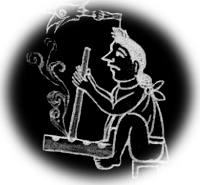
Tianquiztli
 The group of stars that we know as Pleiades symbolized for the Mexicas Tianquiztli, wich means market, perhaps because of the crowd that gathers on them, they're generally represented by one or two people inside a circle with goods.
The group of stars that we know as Pleiades symbolized for the Mexicas Tianquiztli, wich means market, perhaps because of the crowd that gathers on them, they're generally represented by one or two people inside a circle with goods.
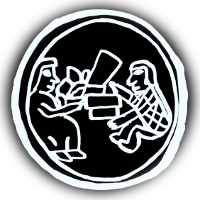
Currently, in Mexico the informal market or street markets are called Tianguis.
Citlaltlachtli
 The constellation of Gemini was called Citlaltlachtli, which means the ball game of the stars. This game was endowed with a ritual significance and used a natural rubber ball. It is said that the movement of the ball within the playing field refers to the movement of the sun and moon.
The constellation of Gemini was called Citlaltlachtli, which means the ball game of the stars. This game was endowed with a ritual significance and used a natural rubber ball. It is said that the movement of the ball within the playing field refers to the movement of the sun and moon.
Xonecuilli
 The Ursa Minor constellation is identified as Xonecuilli wich means twisted foot, and is related to Nanahuatzin, this character is represented with twisted feet, filled with boils and sores, this sick and poor God sacrificed himself to become Tonatiuh the Sun god.
The Ursa Minor constellation is identified as Xonecuilli wich means twisted foot, and is related to Nanahuatzin, this character is represented with twisted feet, filled with boils and sores, this sick and poor God sacrificed himself to become Tonatiuh the Sun god.
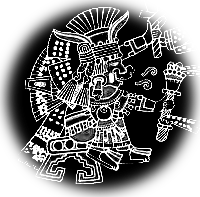
Apparently, this constellation can also be associated with the Southern Cross and its surrounding stars as is referred by Tezozomoc. For its part, Sahagun speaks of his resemblance to bread made in the form of letter S and called by the Aztecs xonecuilli.
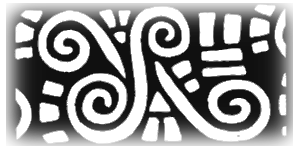
xonecuilli
Citlalcolotl
 According to the Florentino Codex Sahagun's informants identified a group of stars known as Citlalcolotl, the scorpion star. In turn, Tezozomoc also mentions the scorpion star and he called it Colotlixayac, which means face of a scorpion.
According to the Florentino Codex Sahagun's informants identified a group of stars known as Citlalcolotl, the scorpion star. In turn, Tezozomoc also mentions the scorpion star and he called it Colotlixayac, which means face of a scorpion.
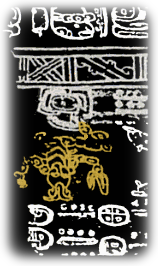
Paris Codex
In a section of the Paris Codex called zodiac pages appears the scorpion, in this codex the icons shows figures of animals hanging from the body of the Celestial Dragon.
Conclusion
It is noteworthy that the interpretation of some of these constellations are still in discussion, and of course there must be other constellations to represent. Any comments and/or collaboration are welcome in order to preserve the stellar knowledge and meaning of the Aztec culture.
External links
Thanks to
- Javier Gómez Sandoval
- Martha Patricia Rivera
- Emilio Ramón Bolaños Guerra
- Hector Vega
- Rafael Rojas Segoviano
- Juan Caballero
- SAAGS
Author
Enrique Gómez Candelario
aldeaglobal@gmail.com
http://www.wirikuta.org/comala
English translation by:
Rafael Rojas Segoviano
 For ancient aztecs, the knowledge of the night skies and stars movement had great importance for their calendars and the measurement of both agricultural and sacred cycles. However, great part of this knowledge was lost as consequence of the Spanish conquest which occurred on continental America in the 16th century.
For ancient aztecs, the knowledge of the night skies and stars movement had great importance for their calendars and the measurement of both agricultural and sacred cycles. However, great part of this knowledge was lost as consequence of the Spanish conquest which occurred on continental America in the 16th century.

 Ancient Aztec indentified the Orion's Belt as Mamalhuaztli, and it represented the wood sticks used to light the new fire in the commemoration celebrated every 52 years by the Mexicans and their neighbors named toxiuh molpilia wich means binding of the years and coincided with the beginning of the new year named xiuhtzitzquilo.
Ancient Aztec indentified the Orion's Belt as Mamalhuaztli, and it represented the wood sticks used to light the new fire in the commemoration celebrated every 52 years by the Mexicans and their neighbors named toxiuh molpilia wich means binding of the years and coincided with the beginning of the new year named xiuhtzitzquilo.
 The group of stars that we know as Pleiades symbolized for the Mexicas Tianquiztli, wich means market, perhaps because of the crowd that gathers on them, they're generally represented by one or two people inside a circle with goods.
The group of stars that we know as Pleiades symbolized for the Mexicas Tianquiztli, wich means market, perhaps because of the crowd that gathers on them, they're generally represented by one or two people inside a circle with goods.
 The constellation of Gemini was called Citlaltlachtli, which means the ball game of the stars. This game was endowed with a ritual significance and used a natural rubber ball. It is said that the movement of the ball within the playing field refers to the movement of the sun and moon.
The constellation of Gemini was called Citlaltlachtli, which means the ball game of the stars. This game was endowed with a ritual significance and used a natural rubber ball. It is said that the movement of the ball within the playing field refers to the movement of the sun and moon. The Ursa Minor constellation is identified as Xonecuilli wich means twisted foot, and is related to Nanahuatzin, this character is represented with twisted feet, filled with boils and sores, this sick and poor God sacrificed himself to become Tonatiuh the Sun god.
The Ursa Minor constellation is identified as Xonecuilli wich means twisted foot, and is related to Nanahuatzin, this character is represented with twisted feet, filled with boils and sores, this sick and poor God sacrificed himself to become Tonatiuh the Sun god.

 According to the Florentino Codex Sahagun's informants identified a group of stars known as Citlalcolotl, the scorpion star. In turn, Tezozomoc also mentions the scorpion star and he called it Colotlixayac, which means face of a scorpion.
According to the Florentino Codex Sahagun's informants identified a group of stars known as Citlalcolotl, the scorpion star. In turn, Tezozomoc also mentions the scorpion star and he called it Colotlixayac, which means face of a scorpion.